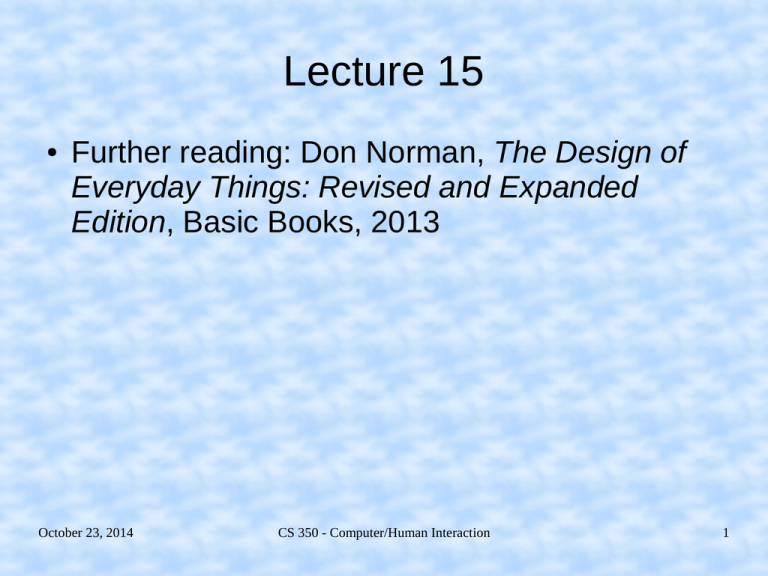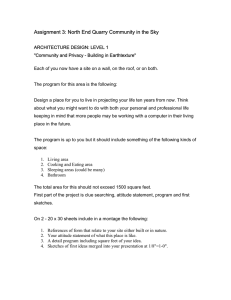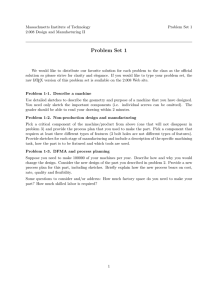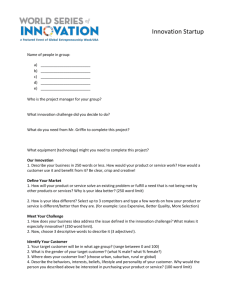Lecture 15 The Design of Everyday Things: Revised and Expanded Edition
advertisement

Lecture 15 ● Further reading: Don Norman, The Design of Everyday Things: Revised and Expanded Edition, Basic Books, 2013 October 23, 2014 CS 350 - Computer/Human Interaction 1 Outline ● Discuss smart fridge sketches ● Chapter 8 – Mental models – Metaphors – Conceptual design – Storyboards – Embodied interaction October 23, 2014 CS 350 - Computer/Human Interaction 2 Introduction October 23, 2014 CS 350 - Computer/Human Interaction 3 Mental Models ● ● From Wikipedia: “an explanation of someone's thought process about how something works in the reals world.” Designer’s mental model – Vision of how system works as held by designer ● ● ● October 23, 2014 What the system is How it is organized What it does and how CS 350 - Computer/Human Interaction 4 Mental models ● User’s mental model – ● Description of how system works as held by user Conceptual design is what is used to connect the two October 23, 2014 CS 350 - Computer/Human Interaction 5 Designer’s mental model in ecological perspective ● ● Describes how system works within its environment How system or product fits within work context – ● In flow of activities involving it and other parts of broader world Example: thermostat in a heating system October 23, 2014 CS 350 - Computer/Human Interaction 6 Designer’s mental model in interaction perspective ● Describes how users operate system or product ● Task-oriented view, including ● – User intentions – Sensory, cognitive, and physical user actions – Includes device behavior Example: thermostat displays ambient and target temperatures, allows user to set target temperature. What about visual feedback explaining what is happening? October 23, 2014 CS 350 - Computer/Human Interaction 7 Designer’s mental model in emotional perspective ● ● ● Describing intended emotional impact About expected overarching emotional response Example: not too much for a thermostat, but perhaps visual or physical design to fit in with house décor or excellence of craftsmanship October 23, 2014 CS 350 - Computer/Human Interaction 8 User's mental model ● Internal explanation user has built about how system works ● It’s what we do naturally in unfamiliar situations ● Starts with imperfect theories ● Draws on expertise and previous experience ● Example: many thermostats work the same, so after learning one can operate others, but newer programmable thermostats can be frustrating because user has no mental model of how one works. October 23, 2014 CS 350 - Computer/Human Interaction 9 Conceptual design as mapping October 23, 2014 CS 350 - Computer/Human Interaction 10 Mapping designer to users ● ● Goal: Get user’s mental model to match reality of designer’s mental model Implementation of this mapping – ● The part of an interaction design containing a theme – ● Conceptual design as manifest in system For communicating design vision Where you innovate to plant seed of UX October 23, 2014 CS 350 - Computer/Human Interaction 11 Metaphors ● Analogies for communication and explanations – Explain unfamiliar using familiar conventional knowledge – Use what users already know about existing system or phenomena – Adapt to help user learn how to use new system October 23, 2014 CS 350 - Computer/Human Interaction 12 Metaphors ● Example: typewriter metaphor in a word processing system – One of simplest and oldest examples – So old, in fact, that it has become a “dead metaphor” and works in reverse October 23, 2014 CS 350 - Computer/Human Interaction 13 Examples of metaphors ● Ecological perspective example – ● iTunes as a mother ship for iPods, iPhones, and iPads Interaction perspective example – Actions for reading a book on an iPad, Kindle, or Nook “turn” pages October 23, 2014 CS 350 - Computer/Human Interaction 14 Examples of metaphors ● Emotional perspective example – Ad in Backpacker magazine for Garmin handheld GPS ● ● October 23, 2014 “Like an old pair of boots and your favorite fleece” “The ideal hiking companion” CS 350 - Computer/Human Interaction 15 Conceptual design in three perspectives ● Ecological perspective – ● To communicate design vision of system as a black box within its environment Interaction perspective – To communicate design vision of how user operates system October 23, 2014 CS 350 - Computer/Human Interaction 16 Conceptual design in three perspectives ● Emotional perspective – To communicate a vision of how design elements will evoke emotional impact – Example, for a sports car: ● ● ● October 23, 2014 About jaw-dropping performance About how your heart skips a beat when you see its aerodynamic form About fun and being independent from crowd CS 350 - Computer/Human Interaction 17 Example: early conceptual design for Ticket Kiosk System ● Immersion in ecological perspective October 23, 2014 CS 350 - Computer/Human Interaction 18 Example: early conceptual design for Ticket Kiosk System ● Broad environmental view in ecological perspective October 23, 2014 CS 350 - Computer/Human Interaction 19 Example: ecological conceptual design ● Focusing on feature for smart ticket to guide users to seating October 23, 2014 CS 350 - Computer/Human Interaction 20 Example: ecological conceptual design ● Focusing on communication with a smartphone October 23, 2014 CS 350 - Computer/Human Interaction 21 Example: ecological conceptual design ● Focusing on social networking October 23, 2014 CS 350 - Computer/Human Interaction 22 Example: conceptual design in interaction perspective October 23, 2014 CS 350 - Computer/Human Interaction 23 Storyboards ● ● ● ● ● Sequence of visual “frames” Illustrating interplay between user and envisioned system Brings design to life in graphical “movie clips” Freeze-frame sketches of stories of how people will work with system. Visual design scenarios, envisioned interaction design solutions October 23, 2014 CS 350 - Computer/Human Interaction 24 Storyboards ● “Comic-book” style illustration of scenario – Actors – Screens – Interaction – Dialogue showing sequences of flow from frame to frame October 23, 2014 CS 350 - Computer/Human Interaction 25 Include in storyboards ● ● ● ● Hand-sketched pictures annotated with a few words All work practice that is part of task, not just interaction with system Example, include telephone conversations with agents outside system Sketches of devices and screens October 23, 2014 CS 350 - Computer/Human Interaction 26 Include in storyboards ● Any connections with system internals, for example, flow to and from a database ● Physical user actions ● Cognitive user actions in “thought balloons” ● Extra-system activities, such as talking with a friend about what ticket to buy October 23, 2014 CS 350 - Computer/Human Interaction 27 Example: Ecological storyboard sketches October 23, 2014 CS 350 - Computer/Human Interaction 28 Example: Ecological storyboard sketches October 23, 2014 CS 350 - Computer/Human Interaction 29 Example: Ecological storyboard sketches October 23, 2014 CS 350 - Computer/Human Interaction 30 Example: Ecological storyboard sketches October 23, 2014 CS 350 - Computer/Human Interaction 31 Example: Ecological storyboard sketches October 23, 2014 CS 350 - Computer/Human Interaction 32 Example: More ecological storyboard sketches October 23, 2014 CS 350 - Computer/Human Interaction 33 Example: More ecological storyboard sketches October 23, 2014 CS 350 - Computer/Human Interaction 34 Example: More ecological storyboard sketches October 23, 2014 CS 350 - Computer/Human Interaction 35 Example: More ecological storyboard sketches October 23, 2014 CS 350 - Computer/Human Interaction 36 Example: More ecological storyboard sketches October 23, 2014 CS 350 - Computer/Human Interaction 37 Example: Interaction perspective storyboard sketches October 23, 2014 CS 350 - Computer/Human Interaction 38 Example: Interaction perspective storyboard sketches October 23, 2014 CS 350 - Computer/Human Interaction 39 Example: Interaction perspective storyboard sketches October 23, 2014 CS 350 - Computer/Human Interaction 40 Example: Interaction perspective storyboard sketches October 23, 2014 CS 350 - Computer/Human Interaction 41 Example: Interaction perspective storyboard sketches October 23, 2014 CS 350 - Computer/Human Interaction 42 Example: Interaction perspective storyboard sketches October 23, 2014 CS 350 - Computer/Human Interaction 43 Example: Interaction perspective storyboard sketches October 23, 2014 CS 350 - Computer/Human Interaction 44 Example: Interaction perspective storyboard sketches October 23, 2014 CS 350 - Computer/Human Interaction 45 Importance of between-frame transitions ● ● Storyboard frames – Individual states – Static screenshots Frame-to-frame progression of interaction over time October 23, 2014 CS 350 - Computer/Human Interaction 46 Importance of between-frame transitions ● ● ● ● ● The dynamics in transitions between frames is where user experience lives Transitions are where users think Cognitive affordances in your design earn their keep Help users think about what to do next Where most problems for users, challenges for designers October 23, 2014 CS 350 - Computer/Human Interaction 47 Importance of between-frame transitions ● ● Make actions between frames part of what is sketched How? – Add frames that show circumstances that lead to transitions – User thought bubbles, gestures, reactions October 23, 2014 CS 350 - Computer/Human Interaction 48 Example: storyboard transition frame ● Thought bubble explaining state change October 23, 2014 CS 350 - Computer/Human Interaction 49 Example: storyboard transition frame ● Thought bubble explaining state change October 23, 2014 CS 350 - Computer/Human Interaction 50 Example: storyboard transition frame ● Thought bubble explaining state change October 23, 2014 CS 350 - Computer/Human Interaction 51 Design for embodied interaction ● ● Embodied interaction – Involves user’s physical body in interaction with technology – In a natural way, such as by gestures Moving interaction off screen and into actionsituated real world October 23, 2014 CS 350 - Computer/Human Interaction 52 Design for embodied interaction ● Embodiment – “How nature of living entity’s cognition shaped by form of its physical manifestation in world.” – Central to idea of phenomenological interaction – Dourish: “How we understand the world, ourselves, and interaction comes from our location in a physical and social world of embodied factors.” October 23, 2014 CS 350 - Computer/Human Interaction 53 Example: Scrabble Flash Game October 23, 2014 CS 350 - Computer/Human Interaction 54




